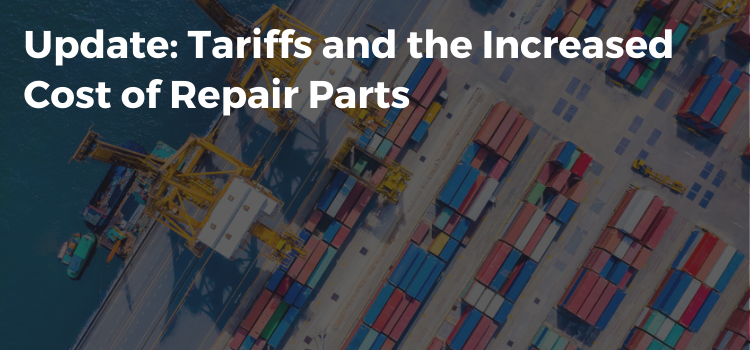Update: Tariffs and the Increased Cost of Repair Parts

The potential implementation of increased tariffs on Canada and Mexico raises concerns about the impact on trade relations and the broader economy. While both countries have expressed a willingness to address President Trump’s concerns, the threat of a 25% tariff hike was decided February 1st. It’s a much larger play than the moves against Colombia, which accounts for roughly 0.5% of U.S. imports. By contrast, nearly 30% of all U.S. imports hail from Canada and Mexico. The auto industry is largely affected, as parts and components can cross national borders several times before a vehicle’s final assembly in the U.S., Canada or Mexico. The proposed tariffs on imports, particularly in sectors like pharmaceuticals, steel, and semiconductors, could have significant ripple effects on the collision industry in the United States.
Increased Cost of Repair Parts:
The U.S. relies heavily on imported collision repair parts, with a significant portion coming from countries like China, Mexico, and Canada. These parts include critical components such as sheet metal parts, electrical components, airbags, and ADAS sensors. If tariffs were imposed on these goods, the cost of replacement parts would rise, impacting the overall expense of car repairs for consumers. 44% of OEM parts used for collision repair are produced outside of the U.S. and would be subject to tariffs. Virtually all aftermarket parts are produced in Taiwan and would also be subject to tariffs. 8.5 parts of the industry average 13.5 parts replaced per estimate would be potentially impacted by tariffs and could raise the parts costs by $100 per estimate.
Higher Repair Costs for Consumers:
With the largest portion of a repair estimate cost coming from parts, any increase in the price of imported collision parts could hit us right in the wallet. And let’s not forget about those fancy semiconductors that keep our modern vehicles running smoothly – tariffs on those could lead to even more expensive fixes and longer waits for repairs.
Supply Chain Disruptions:
The supply chain is a delicate dance of parts and pieces from all over the globe. Throw in some tariffs on steel, plastics, or electronics, and you’ve got yourself a recipe for a supply chain disaster.
Impact on Auto Insurance Industry:
The collision repair sector and the insurance industry are interconnected, and when the cost of repairs rises, insurance companies may respond by raising premium rates for consumers to offset the higher expenses. This has a ripple effect, impacting car owners, repair shops, and insurance companies alike.
Challenges for the United States Steel Industry:
The imposition of additional steel tariffs is indeed a cause for concern across various industries, including the collision repair sector. The US crude steel capacity has been operating below 80% since mid-2022 due to the increase in capacity to meet demand, and the reduction of imports due to previously imposed tariffs. Steel is a crucial material for repairing damaged vehicles, and any disruptions in its availability or pricing can directly impact the cost and timeline of repairs.
Imposing additional tariffs could exacerbate this issue further, impacting the utilization rates and potentially leading to an oversupply of steel.
Higher Repair Costs for Consumers:
The impact of a 25% tariff increase could be devastating for companies importing from Canada and Mexico, with import taxes potentially increasing by $106 billion and $131 billion annually, respectively. The transportation and automotive industries are expected to be hit the hardest, with significant operations in both countries and a high volume of components and parts being imported.
****U.S. INTERNATIONAL TRADE IN GOODS AND SERVICES***
NOVEMBER 2024 Release Number: CB 25-05, BEA 25-01 January 7, 2025 —
The U.S. Census Bureau and the U.S. Bureau of Economic Analysis announced today that the goods and services deficit was $78.2 billion in November, up $4.6 billion from $73.6 billion in October, revised.
Year-to-date 2024, the goods and services deficit increased $93.9 billion, or 13.0 percent, from the same period in 2023.
Exports increased $111.5 billion or 4.0 percent. Imports increased $205.3 billion or 5.8 percent.
It is estimated that taxes on imports in the transportation sector could increase from $4 billion to $68 billion annually. How companies will absorb these costs, or potentially pass them along to consumers, remains uncertain.
Stay tuned for the latest updates and insights and check back regularly for recent blog posts and valuable information about the collision repair industry!

